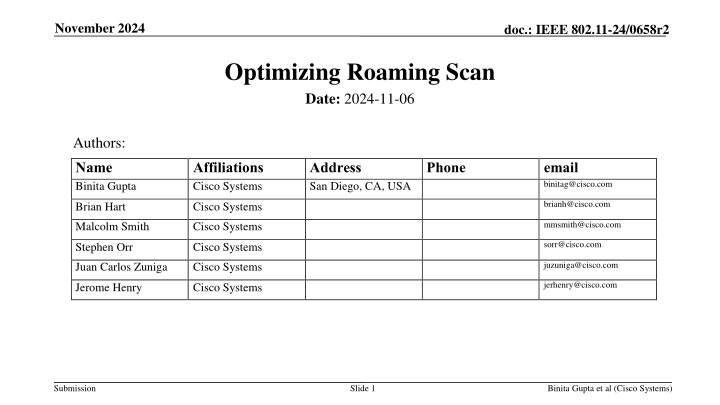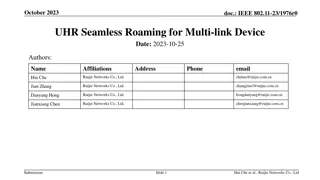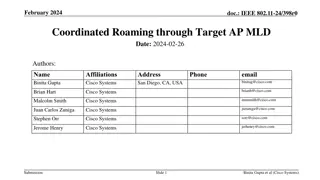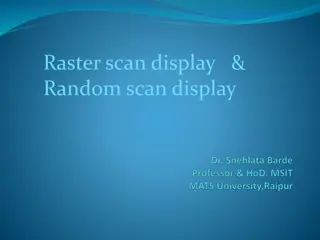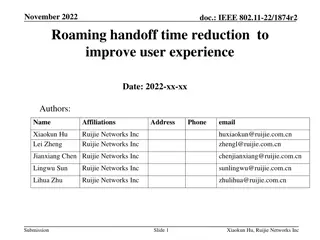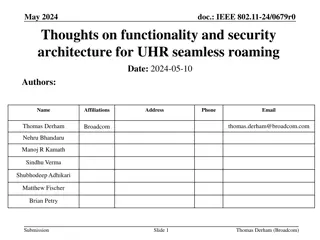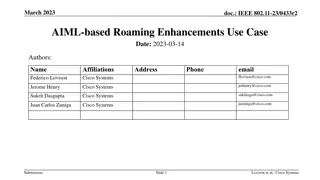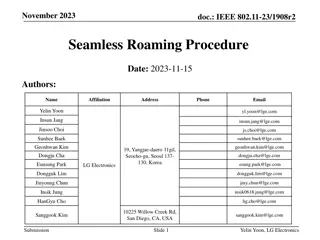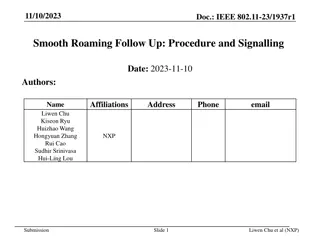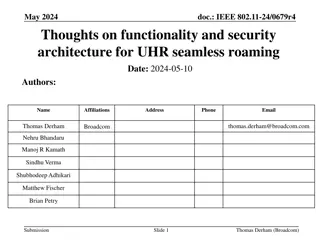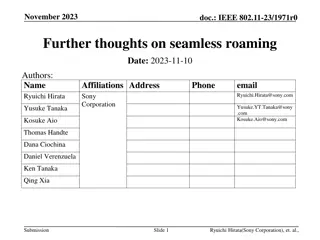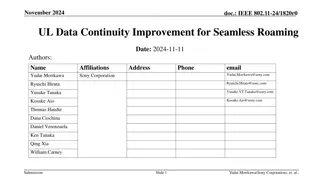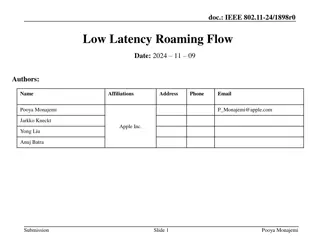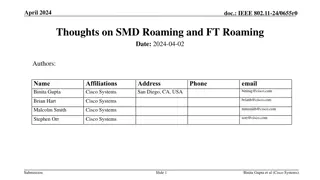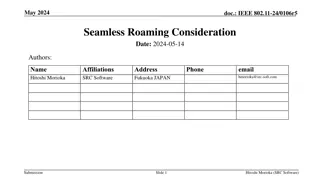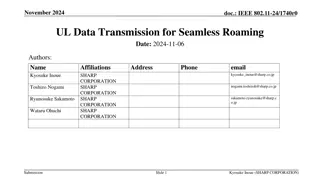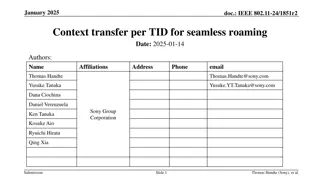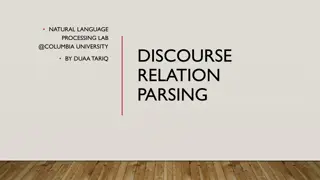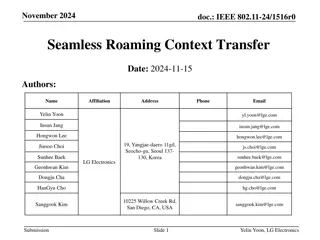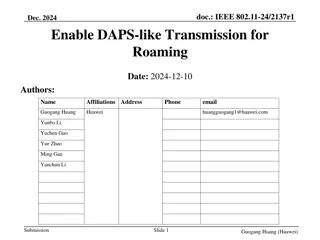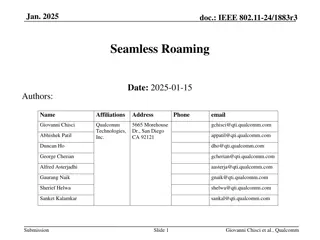Optimizing Roaming Scan for Seamless Connectivity
Presentation on enhancing the roaming scan process to discover neighboring access points more efficiently for seamless roaming in wireless networks. The focus is on minimizing disruptions to transmissions and improving quality of service during roaming procedures.
Download Presentation

Please find below an Image/Link to download the presentation.
The content on the website is provided AS IS for your information and personal use only. It may not be sold, licensed, or shared on other websites without obtaining consent from the author.If you encounter any issues during the download, it is possible that the publisher has removed the file from their server.
You are allowed to download the files provided on this website for personal or commercial use, subject to the condition that they are used lawfully. All files are the property of their respective owners.
The content on the website is provided AS IS for your information and personal use only. It may not be sold, licensed, or shared on other websites without obtaining consent from the author.
E N D
Presentation Transcript
November 2024 doc.: IEEE 802.11-24/0658r2 Optimizing Roaming Scan Date: 2024-11-06 Authors: Name Binita Gupta Affiliations Cisco Systems Address San Diego, CA, USA Phone email binitag@cisco.com brianh@cisco.com Brian Hart Cisco Systems mmsmith@cisco.com Malcolm Smith Cisco Systems sorr@cisco.com Stephen Orr Cisco Systems juzuniga@cisco.com Juan Carlos Zuniga Cisco Systems jerhenry@cisco.com Jerome Henry Cisco Systems Submission Slide 1 Binita Gupta et al (Cisco Systems)
November 2024 doc.: IEEE 802.11-24/0658r2 Introduction Before seamless roaming (SR) procedure is initiated, the non-AP MLD needs to discover neighboring AP MLDs for roaming candidate selection. Current client behavior of performing off-channel roaming scan to discover candidate neighboring APs for roaming target selection is very disruptive to ongoing transmissions and to QoS flows, and needs improvement In this presentation, we define enhancements to optimize overall roaming scan and discovery procedure for discovering neighboring AP MLDs for seamless roaming We need ways to discover information about neighboring AP MLDs through serving AP MLD to minimize off-channel scan and discovery overhead Submission Slide 2 Binita Gupta et al (Cisco Systems)
November 2024 doc.: IEEE 802.11-24/0658r2 SMD Association and Seamless Roaming Flow Before SMD association, non-AP MLD does baseline scan to discover AP MLDs. Then performs auth+assoc procedure with the SMD through an AP MLD. Post SMD assoc, a non-AP MLD needs to discover one or more neighboring AP MLDs and then select candidate target AP MLD(s) for seamless roaming. Neighbor discovery + candidate selection can involve: Client initiated neighbor discovery and then down selecting candidate target AP MLD(s) for SR Serving AP MLD can provide recommendation for specific SR candidates. Non-AP MLD may fetch probe response content of neighbor AP MLD(s) through serving AP, for candidate selection Then roaming prep and roaming exec are performed SMD Serving AP MLD Non-AP MLD Candidate Target AP MLDs Baseline scan Initial auth+association with SMD Neighbor discovery + candidate(s) selection Roaming initiated by STA Link Reconfig Request (for roaming prep.) Static context transfer + link setup Link Reconfig Response Link Reconfig Request (for roaming exec.) Dynamic context transfer DS mapping update Link Reconfig response Submission Slide 3 Binita Gupta et al (Cisco Systems)
November 2024 doc.: IEEE 802.11-24/0658r2 Neighbor Discovery & Candidate Selection for SR Neighbor discovery + candidate selection for SR through serving AP can include: 1. Client discovering basic information for neighboring AP MLDs 2. Client then down selects to one or few neighboring AP MLDs as SR candidate and can discover detailed probe response content for those neighboring AP MLDs (if needed) Both RNR and NR elements can provide basic set of information for neighboring APs RNR can provide info for collocated & non-collocated APs (e.g. in Probe Resp, but not in beacon due to bloating) NR elements can provide basic info for neighbor APs & SMD (e.g. in BTM Request, in Neighbor Report Response) See 24/656 for RNR and NR enhancements for SMD Step 1 can be accomplished by: Extending BTM Query to specifically request for neighbor discovery info in BTM Request (can be provided in NR elements and/or RNR) + unsolicited push of neighbor info/recommendation in BTM Request. Client using Neighbor Report Req/Resp to fetch info for neighbor APs including SMD info in NR element Step 2 can be accomplished by: Client performing neighbor Probe Request/Response to retrieve detailed probe response content for selected neighboring AP MLDs, through the current AP MLD Client implementations may choose to perform step 1 or step 2 or both for neighbor discovery for SR Submission Slide 4 Binita Gupta et al (Cisco Systems)
November 2024 doc.: IEEE 802.11-24/0658r2 Extend BTM Query and BTM Request (1) BTM Query: Define new BSS Transition Query Reason values to query for neighbor discovery info E.g. define values for Neighbor Discovery or Neighbor Discovery within SMD or Neighbor Recommendation for SR Add (Extended) Request element, to allow requesting for RNR and other specific elements to be sent in BTM Request. Alternatively, can define rules on what elements must be provided for neighbor discovery for SR. Extended Request element Request element variable variable BTM Request: Enhance to provide RNR element + other relevant elements (SMDE, RSNE, RSNXE etc.) in Optional Subelements of the NR element RNR can provide more MLD level info than NR, e,g, BPCC, Disabled Link info, hence useful to provide RNR Serving AP returns set of Neighboring APs based on Query Reason (e.g. return neighbor APs only in the SMD) Can apply inheritance across NR elements, e.g. include RSNE/RSNXE only once, if same across reported APs RNR element variable Submission Slide 5 Binita Gupta et al (Cisco Systems)
November 2024 doc.: IEEE 802.11-24/0658r2 Extend BTM Query and BTM Request (2) Unsolicited BTM Request by Serving AP: Today an AP can send unsolicited BTM Request to recommend BSS transition (e.g. for load balancing) Disassociation Imminent can be set to 0 or 1 For seamless roaming, there are other reasons for which current AP MLD can send a BTM Request: Neighbor Discovery Info push - when AP wants to push Neighbor Info after dynamic changes such as BSS Load Neighbor Recommendation for SR - when AP wants to recommend set of neighbor APs to consider if/when performing SR Pre-roaming Preparation Completion for SR - when AP wants to indicate that neighbor AP MLDs are prepared with static context for client to directly roam through the target AP MLD (if needed) In all these cases, Disassociation Imminent = 0. Then Disassociation Timer is reserved (per baseline) We propose to repurpose Disassociation Timer to provide a Reason Code in BTM Request, to signal a reason/purpose for BTM Request Inclusion of Reason Code can be indicated by a Reason Code Included field in Request Mode Submission Slide 6 Binita Gupta et al (Cisco Systems)
November 2024 doc.: IEEE 802.11-24/0658r2 Extend BTM Query and BTM Request (2) Unsolicited BTM Request by Serving AP: Possible Reason Codes - Neighbor Discovery Information push, Neighbor Recommendation for SR, BSS Transition for SR, Pre-roaming Preparation Completion for SR When AP is sending unsolicited BTM Request to UHR clients, it uses the appropriate Reason code value B6 B7 Disassociation Imminent = 0 Reason Code Included Reserved 1 1 When Reason Code Included =1, then Disassociation Timer is repurposed to provide Reason Code Reason Code Reserved 1 1 Submission Slide 7 Binita Gupta et al (Cisco Systems)
November 2024 doc.: IEEE 802.11-24/0658r2 Neighbor Probe Req/Resp through Serving AP (1) A client may need to fetch detailed probe response content for neighboring AP MLD to perform candidate selection for SR We propose to define neighbor Probe Request/Response exchange as extension to 11be ML probe req/resp to probe one or more neighboring AP MLDs through serving AP MLD Extend Probe Req ML element to signal probing for a neighboring AP (neighbor Probe Req ML element) A Probe Request frame that includes neighbor Probe Req ML element(s) is a Neighbor Probe Request A Neighbor Probe Request can include (Extended) Request element(s) to indicate specific elements being requested for neighboring AP MLDs (same as 11be ML probe) Neighbor Probe Request can include one or more neighbor Probe Req ML elements, one for each neighbor AP MLD being probed A Neighbor Probe Response is a Probe Response frame that includes one or more Basic ML element that carries complete or partial profile(s) for neighboring AP MLDs Propose that the neighbor Probe Request/Response frames are exchanged as PMF protected frames with the serving AP MLD, to address privacy concerns Submission Slide 8 Binita Gupta et al (Cisco Systems)
November 2024 doc.: IEEE 802.11-24/0658r2 Neighbor Probe Req/Resp through Current AP (2) SMD After receiving a Neighbor Probe Request, serving AP MLD can use any of the following methods to generate a response Fetch neighbor information directly from each of the requested AP MLDs over-the-DS, or Fetch neighbor information for requested AP MLDs from a controller/WLC, or Use recent cached info for requested AP MLDs Serving AP MLD will return a Neighbor Probe Response that provides information in one or more Basic ML element(s) for neighboring AP MLDs Multiple neighbor Probe Responses can also be returned, one for each neighbor AP MLD (especially when info is being retrieved from neighbor AP MLDs) Serving AP MLD Non-AP MLD Neighbor AP MLDs WLC Neighbor Probe Request (list<neighbor Probe Req ML element [Neighbor AP MLD ID, optional Per-STA Profiles ((Extended) Request elements)]>) Fetch info from neighboring APs or Fetch info from Controller or Respond based on cached info Neighbor Probe Response (list<Basic ML element [Neighbor AP MLD MAC, Per-STA Profiles (Returned elements)]>) Submission Slide 9 Binita Gupta et al (Cisco Systems)
November 2024 doc.: IEEE 802.11-24/0658r2 neighbor (ML) Probe Request neighbor Probe Request A Probe Request frame that includes one or more neighbor Probe Request ML elements(s) Address 1 and Address 3 are set to BSSID of an affiliated AP of the serving AP MLD Indicate in Presence Bitmap a Neighbor AP Probe Indication to signal probing for neighbor AP MLD. AP MLD ID indicates identifier for the neighbor AP MLD. Apply inheritance within and across different neighbor Probe Request ML elements as well. If same Request element and Extended Request element values are applicable for all Neighboring APs, then include these only once (expending the rules from 11be ML probe) B2 B3 B11 Neighbor AP Probe Indication Reserved 1 9 Presence Bitmap field format of the Probe Request Multi-Link element Indicates identifier for Neighbor AP MLD Common Info field format of the Probe Request Multi-Link element Submission Slide 10 Binita Gupta et al (Cisco Systems)
November 2024 doc.: IEEE 802.11-24/0658r2 neighbor (ML) Probe Response neighbor Probe Response A Probe Response frame that Includes one or more Basic ML element for neighbor AP MLDs. If separate probe response is sent for each requested neighbor AP, then only one Basic ML element is included MLD MAC Address is set to the neighbor AP MLD MAC Address. Per-STA Profiles provides affiliated APs information of neighbor AP MLD. Apply inheritance across STA Profiles within and across different Basic ML elements Elements included in the first Per-STA Profile of first Basic ML element can also apply to other Per-STA Profiles in the same and other Basic ML elements included in response frame. Set to Neighbor AP MLD MAC Address Submission Slide 11 Binita Gupta et al (Cisco Systems)
November 2024 doc.: IEEE 802.11-24/0658r2 Conclusion Roaming off-channel scan is expensive in time and power, causes disruption and adds delay to roaming. For seamless roaming it is desired to discover information about neighboring AP MLDs through serving AP MLD to minimize off-channel scan and discovery overhead We propose following enhancements to optimize roaming scan through serving AP MLD: Extend NR and RNR with SMD info (see details in 24/656). Client can continue to use Neighbor Report Req/Resp to request info for neighbor APs in NR elements including SMD info. Extend BTM Query to query for neighbor discovery info for SR and request for RNR and/or selected elements (e.g. SMDE, BSS Load, RSNE etc) in NR elements in the BTM Request Serving AP MLD can provide unsolicited neighbor info/recommendation for SR in BTM Request Extend BTM Request with a Reason code (e.g. by repurposing Disassociation Timer) to indicate reason for unsolicited BTM Request (e.g. Neighbor Discovery Info, Neighbor Recommendation for SR, BSS Transition for SR etc.) Define neighbor Probe Request/Response as extension of 11be ML probe, to enable a non-AP MLD to fetch probe response content for neighbor AP MLDs through the serving AP MLD, using protected (ML) probe req/resp frames These enhancements aim to reuse/extend existing mechanisms for optimizing roaming scan for SR Submission Slide 12 Binita Gupta et al (Cisco Systems)
November 2024 doc.: IEEE 802.11-24/0658r2 Straw Poll 1 Do you agree that a non-AP MLD may use the BTM Query and BTM Request to query and discover necessary information about the neighboring AP MLDs of the serving AP MLD? Neighboring AP MLDs may belong to the same SMD (as the serving AP MLD) or may belong to a different SMD in the same ESS Serving AP MLD can send unsolicited BTM Request to provide information about the neighboring AP MLDs of the current AP MLD Submission Slide 13 Binita Gupta et al (Cisco Systems)
November 2024 doc.: IEEE 802.11-24/0658r2 Straw Poll 2 Do you agree that 11bn defines a mechanism for a non-AP MLD to use PMF protected (ML) probe request/response exchange to discover probe response content for neighboring AP MLDs of the serving AP MLD, through the serving AP MLD? Neighboring AP MLD may belong to the same SMD (as the serving AP MLD) or may belong to a different SMD within the same ESS as the serving AP MLD TBD extension to (ML) probe request/response for probing neighbor AP MLDs Submission Slide 14 Binita Gupta et al (Cisco Systems)
November 2024 doc.: IEEE 802.11-24/0658r2 Straw Poll 3 Do you agree to add a Reason Code to the BTM Request to convey the reason for unsolicited BTM Request frame from the current AP MLD (e.g. Neighbor Discovery Information push, Neighbor Recommendation for SR, BSS Transition for SR, Preroaming preparation completed for SR etc.)? The Reason Code is added by repurposing an existing field (e.g. Disassociation Timer) Submission Slide 15 Binita Gupta et al (Cisco Systems)
